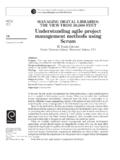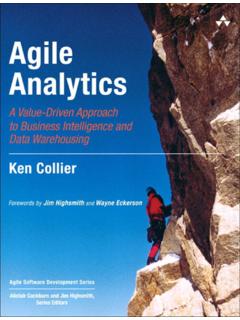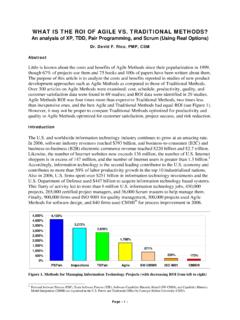Transcription of Scrum - a Bird's Eye View - AgileLeanHouse
1 AgileLeanBooks Scrum - a Bird's Eye view How to lead product development , projects and work in general in a complex world Kurt B. Nielsen & Anne Due Broberg AgileLeanHouse A/S, Lysholt All 6, DK-7100 Vejle, Danmark Version: 2017-10-21. Scrum - a Bird's Eye view Table of Contents Introduction 3. The foundation 3. Where did Scrum and agile come from? 3. A Timeline 4. The Cynefin Framework 6. To the Bird's Eye view then 7. The work is split into iterations 7. All requirements in a single prioritized list of deliverables 8. The players have distinct roles 9. The Product Owner 9. The development Team 9. The Scrum Master 9. The rest of the organization 10. The Scrum activities or ceremony 10. Sprint Planning 1 10. Sprint Planning 2 11. Daily Scrum 11. Sprint Review 12. Sprint Retrospective 12. Product Backlog Refinement 13. Artifacts to improve visibility 13. The Product Backlog 14. The Sprint Backlog 15. The Impediment Backlog 15. The Product Burndown 15.
2 The Sprint Burndown 16. Working in a Sprint 16. Definition of done 17. Summing up 17. Definition of terms 18. Copyright 2017, AgileLeanHouse A/S. All rights reserved. The content of this document is subject to change without notice and does not represent a commitment on the part of agile - LeanHouse A/S. AgileLeanHouse A/S makes no warranty of any kind with regard to this material. AgileLeanHouse A/S shall not be liable for any errors contained herein or damages, including any loss of profits, or other inciden- tal or consequential damages, arising out of your use of this written material. No part of this document may be reproduced or transmitted in any form or by any means, electronic or mechanical, including photocopying, recording, or information recording and retrieval systems, for any purpose, without the express written permission of AgileLeanHouse A/S. All registered and unregistered trademarks used in this document are the exclusive property of their respective owners.
3 Document ID WP- Scrum -011 Filename ScrumABirdsEyeView32. Author Kurt Nielsen Revised 2017-10-21. ii of 21. Scrum - a Bird's Eye view Introduction Scrum is a way of thinking and working a way to wrestle results and motivation out of projects and undertakings in situations too complex for traditional planning. Scrum is one of the agile Methods and they fit under the larger umbrella of Lean Thinking . Scrum id first and foremost defined through the document The Scrum Guide (SG), that is main- tained by the fathers of Scrum Jeff Sutherland and Ken Schwaber, read more Scrum came from the world of IT projects in the 1990s and rose to prominence in the new millennium as the most widely used of the agile methods to manage projects. Scrum is suf- ficiently general in its foundation to be used in all sorts of projects and initiatives 1 also outside the IT industry. Steve Denning, a thought leader in leadership, management and innovation, once said: If there was a Nobel Prize for management, and if there was any justice in the world, I believe that the prize would be awarded, among others, to Jeff Sutherland, Ken Schwaber and Mike Cohn for their contributions to the invention of Scrum .
4 Scrum really is a revolution in leadership. According to recent research2, companies and teams that are using some form of agile are consistently more successful, Scrum being the most popular with 85% using this. The year 2001 marked the new era: Ken Schwaber wrote his best selling book agile software devel- opment with Scrum and the agile Manifesto was signed by a group of influential software professionals. Since that year Scrum has spread like wildfire. There are now more than certified Scrum Masters under the Scrum Alliance 3 capable of running Scrum pro- jects. As an example, many projects in the public sector in Norway are now required to follow Scrum principles. Why use Scrum and agile methods in initiatives, for example in projects and product devel- opment, then? First of all, there is solid empirical evidence documenting higher yield, lower cost, higher predictability and better stakeholder satisfaction. We also believe that it is beginning to dawn on many decision makers that it is impossible in today's complex projects to come up with the perfect upfront plan.
5 It is not even possible for us to attain perfect specifications; technology changes every day and external dependencies fluctuate as well. We are simply not in an ordered domain in most of our non-trivial projects - we are in the complex domain, and totally different measures are called for. The foundation Where did Scrum and agile come from? Scrum is often called agile project management, and agile is roughly defined as anything work related that is focused on human interactions, results, collaboration with customers and the concept of adapting to change4. In a wider perspective, it is legitimate to see Scrum and agile as part of the greater family of Lean, focusing on customer value, reduc- ing waste and respect for people. However, there is even more to keep in mind when trying to assess the foundation of Scrum and agile . Complexity Science tries to describe how some understanding of complex adaptive systems can be obtained. By definition Complexity Science is complex and hard to contain in a few simple buzzwords.
6 We can start is to look at the Cynefin ( pron.: / k n v n/). 1. We shal use the word Initiatives to cover projects, development of products and services plus work in general. 2. 2016/17 research, Prof. Dr. Ayelt Komus, University of Applied Sciences, Koblenz 3. See 4. See the agile manifesto at 3 af 21. Scrum - a Bird's Eye view framework, formulated by Dave Snowden5. Cynefin has proven very useful in understanding how to deal with the very different situations we experience when managing projects, ini- tiatives and organizations in general. In this perspective, we can begin to understand why Scrum well. A Timeline Fredric Winslow Taylor (USA 1856-1916) was the first to apply sys- tematic study to the subject of work and he became the father of the so-called Scientific Management in the beginning of the 20 th century. His book from 1911 on the subject ( Principles of Scientific Manage- ment ), marked the beginning of an era with focus on efficiency, as most notably can be seen in Henry Ford and his assembly line for the model T.
7 Taylor's ideas gave birth to concepts such as the Gantt chart and bud- geting. Taylor, however, being deeply rooted in industrial production, was completely convinced that every piece of work could be reduced to a set of simple repeatable tasks, which could be measured and studied. It would always be possible for the expert to find a best way of doing things (best practice). Taylor's view of the average human being was not attractive however. He basically consid- ered the average worker too stupid and lazy to have influence on his own work; experts had to plan for him and drive him with a combination of carrot and stick to do something, execute tasks. This concept is still with us today. Henri Fayol. (France 1841 1925) was a mining engineer who ended up being in charge of a large mining company. Here he developed over the years a set of 14 principles that he was convinces were absolutely foun- dational to running a large company. In 1916 he published the book Ad- ministration Industrielle et G n rale, one of the first works with a clear theory for management and still one of the most elaborate.
8 Although Fayol is not generally well known, his ideas about administra- tion, line of command etc. has had a profound influence over the last 100 years. His view of management as those delegate, coordinate, su- pervise and cotnrol work is still with us. Alfred Pritchard Sloan, Jr. (USA 1875 1966) was a long-time presi- dent, chairman, and CEO of General Motors Corporation. He reorga- nized the company in a way that became the template for almost all companies in the 20th century. He divided General Motors into sepa- rate autonomous divisions that were subject only to financial, bud- getary and policy controls from a small central staff. Sloan also intro- duced a systematic, detailed strategic planning procedures for the company's divisions, the first CEO ever to do that. His focus on budgets and minute upfront planning is still with us today. Walter A. Shewhart (USA 1891-1967) var physician, engineer and s statistician, he described as the first ever the possibilities ofr statisti- cal quality control.
9 He did this during his work at Western Electric in the 1920s. Shewhart's work showed the necessity of reducing variation in production processes and work in general. In this way he fathered the first ideas about constant improvement. Shewhart created the first versions of control charts, that later have been widely used to monitor 5. For an introduction watch this video presentation 4 of 21. Scrum - a Bird's Eye view all sorts of processes, in order to determine if the results are likely to be caused by ran- dom variation in the process or specific causes that can be hunted down. W. Edwards Deming (USA 1900 1993) has contributed to a total focus on quality and involving the whole person in the work process. He was in opposition to Taylor, Ford and Sloan. He contributed to the Ameri- can war effort during the Second World War by helping create and teach the quality standards crucial to the precision manufacturing of America's war equipment.
10 Later, in the 1950s, Deming was instrumen- tal in Japan's transformation into a first class industrial nation. He learned a lot from his mentor Shewhart in the 1930s and he can in many ways be considered to be the father of Lean. In the 1980s Toyota's operating models in production, product devel- opment and supply chain management became known in the Western world, and this spawned a change in ways of organizing work in the years to come. We know this now as Lean . Tom Gilb is an American software consultant living in Norway. In the 1980s he came into the software world with the book Princi- ples of Software Engineering Management 6 from 1988. In the book Gilb describes, among other things, an iterative development - and delivery principle called Evo, which still remains valid today. If Deming is the great-grandfather of Scrum as we know it today, Gilb would for sure be the grandfather. He is still active as a coach and consultant today.






